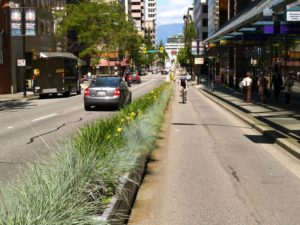Vancouver, has aggressive aspirations for sustainability. Its goal is to be entirely powered by clean energy by 2050 — not just electricity, but transportation and heating as well.
As part of that effort, Vancouver adopted the goal of 50 percent “sustainable mode share” by 2020 — half of all trips in the city taken by walking, biking, or transit rather than automobile.
The video above, by Clarence Eckerson Jr. of Streetfilms, tells the story of how it happened. As Brent Toderian, a former Vancouver chief planner, explains in the film, the city’s success traces all the way back to the 1960s and ’70s, when the extraordinarily prescient citizens of Vancouver rejected a plan to build a network of urban freeways through the city.
Today, Vancouver remains the only major city in North America unmarred by freeways.

Vancouver’s SkyTrain, Brentwood Station.
(wikipedia)
There’s Vancouver’s automated, grade-separated SkyTrain system, with trains that, in peak hours, come every 90 seconds. With the opening of its most recent line just this year, it now has 53 stations and carries more than 100 million passengers a year.
The downtown core, along with more and more outlying neighborhoods, is crisscrossed by physically separated bike lanes, making biking substantially safer and more pleasant. Ten percent of all commutes are now done on bicycles, putting Vancouver far ahead of its North American peers.

Biking in Vancouver, separated from cars by a physical median. (Flickr, via Jeff Arsenault)
All those farsighted decisions in decades past are coming together now. Vancouver is becoming not just a city with some nice walkable areas but a nice walkable city.